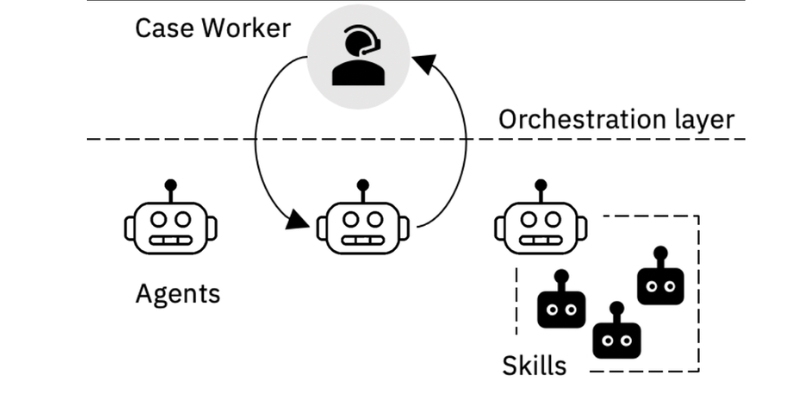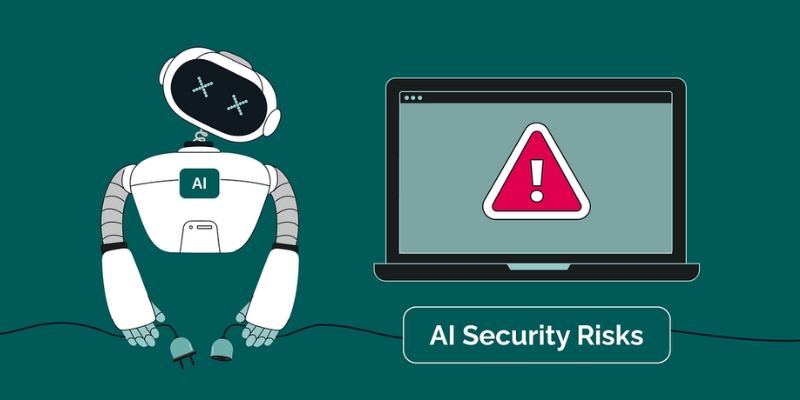Lucia Lee
Last update: 17/09/2025
AI agents are powerful on their own, but when multiple agents need to work together, things can quickly get messy. That’s where AI agent orchestration comes in - coordinating different agents so they don’t just run in silos, but actually collaborate to achieve complex business goals. For companies exploring agentic AI adoption, understanding how orchestration works (and why it matters) can be the difference between a scattered set of tools and a streamlined, ROI-driven AI strategy. Keep scrolling down to discover everything you need to know about AI agent orchestration.
AI agent orchestration is the process of bringing together multiple specialized AI agents under one system so they can work in sync toward a shared objective. At its core, orchestration thrives on agent collaboration, where every agent contributes its expertise at the right time, resulting in a seamless and scalable AI-powered operation. This automation coordination is what enables businesses to streamline complex workflows, reduce inefficiencies, and avoid the bottlenecks of siloed systems.
As businesses scale their use of AI, relying on a single model or chatbot quickly becomes limiting. A lone agent often ends up being a jack-of-all-trades - answering queries, fetching data, processing forms - but as use cases expand, this structure collapses under complexity. Flows become harder to debug, prompts balloon in size, and maintaining clarity over responsibilities turns into a major bottleneck.
This is where AI agent orchestration steps in, becoming a valuable asset for various reasons:
Also read: What is Agentic AI? The Ultimate Guide to Agentic AI
When multiple AI agents need to work together, the way they are organized and directed can make or break efficiency. The orchestration model you choose depends on how much control you want, how much autonomy agents should have, and how communication is managed across the system. Here are the four main types of AI agent orchestration:
Centralized orchestration
In this model, a single AI orchestrator acts like the “conductor” of an orchestra, directing every move of the agents. All decision-making, task assignments, and communications flow through this central hub, ensuring consistency and predictable outcomes. This approach is best suited for businesses that need strict oversight, want to reduce unpredictability, and prefer a highly structured AI framework.

Centralized orchestration
Decentralized orchestration
Here, there is no single “boss” agent. Instead, agents interact directly with one another, making local decisions or even reaching consensus as a group. This model creates a system that’s naturally more flexible and fault-tolerant since no single failure can shut everything down. Businesses looking for scalability, adaptability, and resilience often favor this structure, especially for systems that must evolve and grow over time.
Hierarchical orchestration
Think of this as a corporate ladder for AI agents. Higher-level agents take on the role of supervisors, setting strategy and dividing complex tasks into smaller parts, while lower-level agents focus on execution. This model strikes a balance between centralized control and agent autonomy. However, if the hierarchy is too rigid, it can slow down adaptability. For many organizations, it’s an effective middle ground for maintaining order while still encouraging flexibility.
Federated orchestration
This AI agent orchestration model is built for collaboration across boundaries, where different organizations, teams, or independent agents work together under shared protocols. Each participant maintains control over its own data and systems, but they cooperate to achieve larger goals. It’s especially valuable in sectors like healthcare, finance, or cross-company projects where data sovereignty and privacy are critical. Federated orchestration allows cooperation without requiring full data sharing, offering the best of both security and collaboration.
AI agent orchestration isn’t just about improving efficiency - it transforms how businesses operate, scale, and connect with customers. Here are the core benefits businesses can reap by adopting AI agent orchestration:
Streamlined workflow efficiency
Specialized agents take ownership of distinct tasks such as billing, product recommendations, or troubleshooting. This division of responsibilities eliminates redundancies, reduces manual handoffs, and ensures that workflows run seamlessly from start to finish.
Scalable operations without disruptions
As demand grows, orchestration frameworks make it simple to add more agents without disrupting existing processes. Businesses can expand smoothly into new functions or markets while maintaining stability and efficiency.
Coherent and consistent interactions
Orchestrated multi-agent systems enable agents to share information across touchpoints, ensuring customers receive consistent, context-aware responses. This creates smoother experiences and builds trust by eliminating fragmented or conflicting interactions.

Coherent and consistent interactions
Accelerated decision-making with real-time insights
With orchestrated agents exchanging data instantly, teams can access real-time insights for faster, more accurate decision-making. This allows businesses to react quickly to opportunities or challenges without being slowed down by siloed systems.
Cost-effective automation and resource utilization
Intelligent orchestration optimizes resources by reducing manual intervention and replacing fragmented tools with cohesive workflows. The result of this task delegation is fewer errors, lower operational costs, and more value delivered with the same or even fewer resources.
Hyper-personalized customer experiences
By coordinating multiple specialized agents, orchestration makes it possible to deliver personalized experiences at scale. Customers benefit from tailored product recommendations, relevant promotions, and smoother interactions that drive loyalty and conversions.
Adaptive response to market shifts
Orchestrated agents continuously monitor trends, behaviors, and signals across systems. This adaptability empowers businesses to pivot quickly, adjust strategies, and stay competitive in evolving markets without costly re-engineering.
AI agent orchestration goes beyond individual task automation - it enables specialized agents to work in harmony, driving efficiency, reducing risks, and ensuring better decision-making for businesses. Below are some of the most impactful use cases of AI agent orchestration across industries.
Customer service and support
Customer support is one of the clearest examples of how orchestration transforms operations. Instead of relying on a single chatbot with limited capabilities, multiple agents can collaborate across channels.
For instance, a retail organization may use an account management agent to address routine inquiries while a fraud detection agent monitors suspicious activity. The orchestrator ensures seamless transitions between these agents, carrying over context so that customers receive fast, accurate, and consistent answers. This approach reduces wait times, improves first-contact resolution, and elevates the overall customer experience while also lowering costs.

Customer service and support
Supply chain and logistics
In supply chain management, orchestration brings together agents that manage inventory, logistics, and demand forecasting into a unified flow. An inventory agent can track stock levels and automatically trigger replenishment orders, while a logistics agent optimizes delivery routes and monitors schedules in real time. Forecasting agents, meanwhile, analyze historical data and market trends to predict demand fluctuations. By working in concert, these agents prevent stockouts and overstocking, streamline supplier selection, and keep operations resilient in rapidly changing markets.
Financial services
The financial sector benefits greatly from orchestration by combining fraud detection, risk assessment, and customer advisory agents. Fraud detection agents scan transactions for anomalies in real time, while risk agents evaluate credit scores, loan eligibility, and market conditions. At the same time, customer-facing agents provide personalized recommendations for investments, savings, or insurance products. Orchestration ties these processes together, enabling faster decision-making, reducing compliance risks, and delivering personalized experiences that build client trust and loyalty.
Healthcare systems
Healthcare workflows are inherently complex, spanning electronic health records, scheduling, diagnosis, and regulatory compliance. AI agent orchestration allows specialized agents to coordinate these functions seamlessly. Data agents keep patient records accurate and up to date across systems, scheduling agents optimize appointments according to urgency and availability, and diagnostic agents cross-reference lab results, imaging, and patient histories to ensure more accurate outcomes. By aligning these processes, orchestration reduces administrative burdens, minimizes delays, and empowers providers to focus on delivering higher-quality patient care.

Healthcare systems
Retail and ecommerce
Retailers are increasingly turning to AI agent orchestration to handle inventory, marketing, and customer engagement in a connected way. For example, when a surge in demand is detected, a demand-sensing agent can trigger real-time pricing adjustments, notify fulfillment agents to reroute inventory, and signal marketing agents to shift promotional strategies. At the same time, customer-facing agents handle product recommendations, returns, and inquiries instantly, creating a smoother shopping journey. This coordinated approach enhances efficiency, boosts conversion rates, and improves customer loyalty.
Also read: The Future of AI in the Retail Industry: Trends to Watch
Manufacturing and industrial operations
Manufacturing environments depend on precision and adaptability, both of which AI agent orchestration excels at. When a sensor detects an equipment anomaly, a maintenance agent can immediately schedule repairs, while a procurement agent orders spare parts and a logistics agent adjusts delivery timelines. Instead of operating in silos, these agents act as part of a connected system, reducing downtime and keeping production aligned with real-time supply and demand conditions. The result? Greater resilience, operational efficiency, and a stronger competitive edge.
While AI agent orchestration delivers significant advantages, it also introduces a set of challenges that businesses must carefully manage to ensure success.
Coordination and communication complexity
One of the biggest hurdles in AI agent orchestration is managing smooth coordination across multiple autonomous agents. Each agent may specialize in a different function - such as customer service, fraud detection, or logistics - but ensuring they work in sync requires sophisticated strategies. If communication breaks down, the entire system can suffer.
For example, if a recommendation agent doesn’t receive updated inventory data, it may suggest products that are no longer in stock, resulting in poor customer experiences and lost revenue. Avoiding such scenarios demands strong orchestration frameworks that standardize and streamline agent-to-agent communication.
Scalability limitations
As organizations expand their AI ecosystems, adding more agents often brings exponential complexity. Without a scalable orchestration framework, businesses risk bottlenecks and performance degradation as workloads increase. To maintain efficiency, orchestration systems need modular designs that allow seamless scaling while preserving system stability. Future-proofing orchestration in this way is especially critical in industries like ecommerce or supply chain management, where demand fluctuates rapidly.
Conflict resolution in real-time environments
In fast-moving business contexts, agents may make decisions that clash with one another. A pricing agent, for instance, might lower product prices to boost sales, while an inventory agent might simultaneously flag supply shortages. Without effective conflict resolution mechanisms, these contradictions can disrupt workflows and harm business outcomes. AI agent orchestration frameworks must therefore include clear rules and protocols to handle disputes quickly, maintaining harmony across agents and avoiding operational slowdowns.
Fault tolerance and reliability
Another significant challenge of AI agent orchestration lies in ensuring fault tolerance. If one agent fails - say, a scheduling agent in healthcare or a payment agent in retail - the ripple effect can disrupt entire workflows. To mitigate this risk, orchestration systems must be designed with resilience in mind, including fallback strategies and recovery mechanisms that allow the overall process to continue smoothly even when individual components fail.
Integration with legacy and diverse systems
Bringing new AI agents into existing business infrastructures is rarely straightforward. Many organizations still rely on legacy systems that are not designed for modern, distributed AI environments. Integrating orchestration frameworks with these systems requires significant effort, technical expertise, and resources. Without careful planning, this complexity can delay implementation and increase costs, making it harder for companies to unlock the full value of agent orchestration.
Security and compliance risks
Finally, managing sensitive data across multiple agents introduces critical security and compliance challenges. This is particularly true in industries like healthcare and financial services, where strict regulations govern how data is shared and stored. If orchestrated agents are not aligned with security standards, businesses face risks of data breaches, non-compliance, and reputational damage. Embedding governance, encryption, and compliance checks into the orchestration layer is therefore essential to protect operations and maintain customer trust.

Challenges in AI agent orchestration
Also read: Navigating The Ethical Concerns of Agentic AI
The future of AI agent orchestration is set to be transformative, shaping how businesses automate, adapt, and compete in a rapidly evolving digital economy. As AI technology matures, orchestration will move beyond simple coordination into becoming more autonomous, intelligent, and human-like, with systems capable of learning, reasoning, and adapting in real time.
One major trend is the rise of open-source orchestration platforms that make it easier for businesses of all sizes to experiment and innovate without being locked into a single vendor. Alongside this, generative AI orchestration is expected to become a mainstream capability, enabling organizations to dynamically design customer journeys, automate creative processes, and scale hyper-personalized experiences.
The growing role of large language model (LLM) orchestration will also redefine customer interactions. Businesses will leverage orchestrated LLMs for dynamic customer experiences (CX), delivering conversations and services that feel natural, contextually aware, and adaptive to changing customer needs. Combined with reinforcement learning, these orchestrated systems will continuously optimize themselves, making them smarter and more effective over time.
From an infrastructure perspective, orchestration will benefit from cloud-native technology and edge computing. These advancements will reduce latency, boost performance, and allow orchestration platforms to manage real-time adaptation with minimal human input. Automated conflict resolution and AI-enabled monitoring will further ensure that agent ecosystems remain resilient and secure, even as they grow more complex.
AI agent orchestration is no longer a nice-to-have - it’s becoming the backbone of scalable, adaptive, and intelligent business operations. By coordinating specialized agents, organizations can eliminate inefficiencies, unlock real-time decision-making, and create seamless experiences that keep them ahead in a rapidly evolving digital landscape.
At Sky Solution, we help businesses harness the full power of agentic AI through advanced orchestration frameworks that are secure, scalable, and tailored to your unique needs. If you’re ready to move beyond siloed automation and build AI systems that truly work in harmony, let’s talk about how our agentic AI solutions can transform your business. Contact us now for a free consultation today!